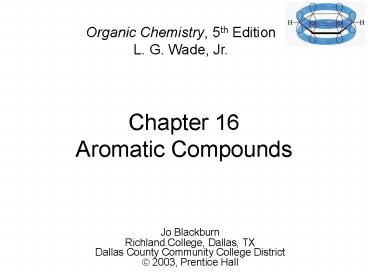Chapter 16 Aromatic Compounds - PowerPoint PPT Presentation
1 / 41
Title:
Chapter 16 Aromatic Compounds
Description:
Synthesized in 1834 by Eilhard Mitscherlich who determined molecular formula to be C6H6. ... Pyridine. Heterocyclic aromatic compound. ... – PowerPoint PPT presentation
Number of Views:175
Avg rating:3.0/5.0
Title: Chapter 16 Aromatic Compounds
1
Chapter 16Aromatic Compounds
Organic Chemistry, 5th EditionL. G. Wade, Jr.
- Jo Blackburn
- Richland College, Dallas, TX
- Dallas County Community College District
- ã 2003, Prentice Hall
2
Discovery of Benzene
- Isolated in 1825 by Michael Faraday who
determined CH ratio to be 11. - Synthesized in 1834 by Eilhard Mitscherlich who
determined molecular formula to be C6H6. - Other related compounds with low CH ratios had a
pleasant smell, so they were classified as
aromatic.
3
Kekulé Structure
- Proposed in 1866 by Friedrich Kekulé, shortly
after multiple bonds were suggested. - Failed to explain existence of only one isomer of
1,2-dichlorobenzene.
Cl2
4
Resonance Structure
- Each sp2 hybridized C in the ring has an
unhybridized p orbital perpendicular to the ring
which overlaps around the ring.
5
Unusual Reactions
- Alkene KMnO4 ?
- Benzene KMnO4
- Alkene Br2/CCl4 ? Benzene Br2/CCl4 ?
- Benzene FeCl3/Br2 ?
6
Unusual Stability
- Hydrogenation of just one double bond in benzene
is endothermic!
7
Annulenes
- All cyclic conjugated hydrocarbons were proposed
to be aromatic. - However, cyclobutadiene is so reactive that it
dimerizes before it can be isolated. - And cyclooctatetraene adds Br2 readily.
- Look at MOs to explain aromaticity.
8
MO Rules for Benzene
- Six overlapping p orbitals must form six
molecular orbitals. - Three will be bonding, three antibonding.
- Lowest energy MO will have all bonding
interactions, no nodes. - As energy of MO increases, the number of nodes
increases.
9
MOs for Benzene
10
Energy Diagram for Benzene
- The six electrons fill three bonding pi orbitals.
- All bonding orbitals are filled (closed shell),
an extremely stable arrangement.
11
MOs for Cyclobutadiene
12
Energy Diagram forCyclobutadiene
- Following Hunds rule, two electrons are in
separate orbitals. - This diradical would be very reactive.
13
Polygon Rule
- The energy diagram for an annulene has the same
shape as the cyclic compound with one vertex at
the bottom.
14
Aromatic Requirements
- Structure must be cyclic with conjugated pi
bonds. - Each atom in the ring must have an unhybridized p
orbital. - The p orbitals must overlap continuously around
the ring. (Usually planar structure) - Compound is more stable than its open-chain
counterpart.
15
Anti- and Nonaromatic
- Antiaromatic compounds are cyclic, conjugated,
with overlapping p orbitals around the ring, but
the energy of the compound is greater than its
open-chain counterpart. - Nonaromatic compounds do not have a continuous
ring of overlapping p orbitals and may be
nonplanar.
16
Hückels Rule
- If the compound has a continuous ring of
overlapping p orbitals and has 4N 2 electrons,
it is aromatic. - If the compound has a continuous ring of
overlapping p orbitals and has 4N electrons, it
is antiaromatic.
17
MO Derivation of Hückels Rule
- Lowest energy MO has 2 electrons.
- Each filled shell has 4 electrons.
18
Arromaticity of NAnnulenes
- 4Annulene?
- 8Annulene?
- 10Annulene?
- Larger annulenes?
19
Cyclopentadienyl Ions
- The cation has an empty p orbital, 4 electrons,
so antiaromatic. - The anion has a nonbonding pair of electrons in a
p orbital, 6 e-s, aromatic.
20
Acidity of Cyclopentadiene
- pKa of cyclopentadiene is 16, much more acidic
than other hydrocarbons.
21
Tropylium Ion
- The cycloheptatrienyl cation has 6 p electrons
and an empty p orbital. - Aromatic more stable than open chain ion
22
Dianion of 8Annulene
- Cyclooctatetraene easily forms a -2 ion.
- Ten electrons, continuous overlapping p orbitals,
so it is aromatic.
23
Pyridine
- Heterocyclic aromatic compound.
- Nonbonding pair of electrons in sp2 orbital, so
weak base, pKb 8.8.
24
Pyrrole
- Also aromatic, but lone pair of electrons is
delocalized, so much weaker base.
25
Basic or Nonbasic?
26
Other Heterocyclics
27
Fused Ring Hydrocarbons
- Naphthalene
- Anthracene
- Phenanthrene
28
Reactivity of Polynuclear Hydrocarbons
- As the number of aromatic rings increases, the
resonance energy per ring decreases, so larger
PAHs will add Br2.
(mixture of cis and trans isomers)
29
Fused Heterocyclic Compounds
- Common in nature, synthesized for drugs.
30
Allotropes of Carbon
- Amorphous small particles of graphite charcoal,
soot, coal, carbon black. - Diamond a lattice of tetrahedral Cs.
- Graphite layers of fused aromatic rings.
31
Some New Allotropes
- Fullerenes 5- and 6-membered rings arranged to
form a soccer ball structure. - Nanotubes half of a C60 sphere fused to a
cylinder of fused aromatic rings.
32
Common Names of Benzene Derivatives
33
Disubstituted Benzenes
The prefixes ortho-, meta-, and para-
are commonly used for the 1,2-, 1,3-, and
1,4- positions, respectively.
34
3 or More Substituents
Use the smallest possible numbers, but the carbon
with a functional group is 1.
35
Common Names forDisubstituted Benzenes
36
Phenyl and Benzyl
Phenyl indicates the benzene ring attachment.
The benzyl group has an additional carbon.
37
Physical Properties
- Melting points
- Boiling points
- Density
- Solubility
38
IR and NMR Spectroscopy
- CC stretch
- sp2 C-H stretch
- 1H NMR
- 13C NMR
39
Mass Spectrometry
gt
40
UV Spectroscopy
41
End of Chapter 16































